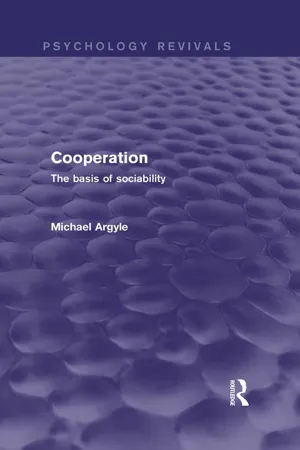Psychology
Non-Verbal Behaviour
Non-verbal behavior refers to communication without the use of words, including body language, facial expressions, gestures, and tone of voice. It plays a crucial role in conveying emotions, attitudes, and intentions. Non-verbal behavior can significantly impact interpersonal interactions and is an important area of study in psychology.
Written by Perlego with AI-assistance
Related key terms
Related key terms
1 of 4
Related key terms
1 of 3
12 Key excerpts on "Non-Verbal Behaviour"
- eBook - ePub
- Richard Gross, Rob McIlveen(Authors)
- 2016(Publication Date)
- Routledge(Publisher)
6 Non-verbal communication and interpersonal behaviour• Introduction • Animal communication • Non-Verbal Behaviour • Gender and cultural issues relating to Non-Verbal Behaviour • Functions of Non-Verbal Behaviour • Interaction of verbal and Non-Verbal Behaviours in conversation • Verbal communication and questioning • Application: health professional–client interaction • Summary • Suggestions for further reading6.1 IntroductionWe spend much of our social lives interacting, face-to-face, with another person or small group of people. This occurs via the medium of both spoken language and non-verbal communication. Verbal communication may be defined as the actual words spoken, whereas non-verbal communication includes both vocal and non-vocal behaviour. Vocal behaviour refers to aspects of speech such as intonation, pitch, speed and hesitations, and non-vocal behaviour includes other communicative behaviour. This includes physical contact (touch), body language, gaze and facial expressions, personal space, appearance, and environmental factors (Hargie et al., 1994) (see Fig. 6.1 ).We may regard these two types of communication as serving different functions. However, it is important to bear in mind that non-verbal communication can substitute for language; the best example of this is sign language used by deaf people. Functionally, verbal communication, in the form of language, is used to convey logical or abstract ideas, whereas non-verbal communication serves a much broader range of functions (Hargie et al., 1994).Early research on Non-Verbal Behaviours tended to concentrate on ‘channels’ of communication in isolation. Each different type of nonverbal behaviour, e.g. contact, proximity, touch, etc. was regarded as a different channel, just like television channels. However, more recent research has developed an ‘across channels’ approach which makes it possible to identify the functions served by different combinations and patterns of Non-Verbal Behaviour (Patterson, 1990). Three basic functions of Non-Verbal Behaviour originally identified by researchers in the late 1960s and early 1970s were: (a) providing information to another person or other people; (b) regulating interaction between two or more people; and (c) expressing intimacy, especially with our loved ones. - eBook - ePub
Interpersonal Communication
Competence and Contexts
- Shelley D. Lane(Author)
- 2016(Publication Date)
- Routledge(Publisher)
Nonverbal communication refers to all forms of communication other than words themselves. This form of communication occurs via gestures, body orientation and posture, touch, facial expression and eye contact, vocal qualities and accents, body shape, clothing and artifacts (such as jewelry and tattoos), the environment in which both verbal and nonverbal communication takes place, and how close or far away we sit or stand from others. Even time is a form of nonverbal communication. Nonverbal behavior is an integral part of the overall study of communication because it is a significant channel for creating and sharing meaning.Even though nonverbal communication is an important channel of meaning, the interpretation of nonverbal behavior isn’t always straightforward because nonverbal communication is ambiguous. One reason that accounts for such ambiguity is that nonverbal behaviors can have various meanings. Consider the various meanings associated with a pat on the back. It can be interpreted as an expression of sympathy (“I’m so sorry”), encouragement (“Way to go!”), or merely an attempt to engage our attention (“Hey!”). The influence of contexts also affects how we interpret nonverbal communication. For example, Navajo children are typically taught that it is impolite to make prolonged eye contact with others. However, lack of eye contact is considered disrespectful in the dominant U.S. culture.3 Nonverbal communication can also be ambiguous because nonverbal behavior may be intentional or unintentional. For example, although we may not consciously and intentionally end our sentences with a rising inflection (sometimes labeled “up-talk”), we may be perceived as insecure or immature on the basis of this nonverbal behavior. Because nonverbal communication is ambiguous, it’s best to interpret nonverbal behavior in conjunction with verbal communication.Nonverbal communication can have many meanings and can influence our behavior.Source: © 1992 Paws, Inc. Reprinted with permission of UNIVERSAL PRESS SYNDICATE. All Rights Reserved. - eBook - ePub
- Elisha Babad(Author)
- 2009(Publication Date)
- Routledge(Publisher)
Part V Nonverbal Behavior in the ClassroomPassage contains an image
12 Basic Concepts and Issues in Nonverbal ResearchWHAT IS NONVERBAL BEHAVIOR AND WHY IS IT IMPORTANT?
Nonverbal behavior (NV) is an integral part of human communication. It consists of all expressive aspects that have no verbal content, no words, and no spoken or written language. The visual and auditory aspects of behavior are all nonverbal: Facial expressions, gestures, body language, postures, movement, voice, tone and vocal clues (without verbal content), attire, and physical appearance. Also included in the NV domain are certain behavioral patterns in interpersonal interaction (e.g., personal space, touching, etc.) and characteristics of the setting and the environment.We live in the era of the visual and are continuously exposed to NV aspects in television and movies. Children learn from a young age to understand NV language, to decipher implicit codes from what they see and hear and to make meaning of social situations from subtle NV nuances. We learn to understand social situations without having to receive verbal explanation. NV behavior is a rich source of information, whereas verbal behavior can be misleading and often deceptive.A good example demonstrating the importance of the NV aspect is the popular internet chat in its form of the 1990s and the early parts of this century. Before the introduction of full picture chat, the chat was based on written verbal exchanges, and people chatted by writing verbal messages to each other. But something was missing in this form of interaction, and a special NV language—in the form of a library of NV icons and pictorial symbols to express emotional states such as happy, sad or smiling—was invented. A growing collection of icons was added to the software to enable the chatters to express NV emotional clues to accompany their verbal interaction. - eBook - ePub
- Bruce M. Rowe, Diane P. Levine(Authors)
- 2022(Publication Date)
- Routledge(Publisher)
Today, the study of nonverbal communication is a dynamic and expanding field. There is an abundance of articles and papers being published each month in popular magazines and professional journals, as well as a growing number of mass-market and specialized books. There was even a US television program, Lie to Me (originally broadcast 2009–2011), about the usefulness of the analysis of nonverbal cues in criminal investigations. 1 Charles Darwin, The Expression of the Emotions in Man and Animals (London: John Murray, 1872). This has been reprinted numerous times (and in several languages), most recently in 2016. What does “nonverbal” mean? A police officer stops a motorist for allegedly speeding. Taking a firm stance very close to the motorist’s car door while maintaining a forbidding gaze, the officer says, “May I see your license?” Fidgeting through his wallet, brows lowered and drawn together, eyes bulging, nostrils dilated, the motorist responds in a sheepish voice, “What did I do wrong?” Not receiving an immediate answer, the motorist begins nervously patting his leg. Only some of the messages being conveyed in this interchange depend on words. All the other messages are conveyed nonverbally. Nonverbal communication is any communication that occurs between people, usually within each other’s presence, by means other than spoken or written words or the signs (words) of a sign language. The firm stance, stern gaze, and the “invasion” of the motorist’s territory may have conveyed the idea of the officer’s authority and dominance. The motorist’s fidgeting, patting himself, and his facial expression may have delivered the message of his nervousness, restlessness, or anger. Nonverbal behavior is important in establishing, regulating, and maintaining interpersonal relationships. Although there are other forms of nonverbal behavior, we will explore the form and function of only eight types in this chapter - eBook - ePub
- Chris Caswell, Sean Neill(Authors)
- 2003(Publication Date)
- Routledge(Publisher)
Chapter 2 What is non-verbal communication?
In this chapter we look at the types of signal covered by the term ‘non-verbal communication’; the following chapters cover how they can be applied in particular circumstances. Non-verbal communication can be defined in a range of ways, but in this book we are concerned with non-verbal signals used in face-to-face interaction mainly actual behaviour, but also signals such as dress and room arrangement which you or the children may ‘set up’ before you meet each other. These ‘set up’ signals allow you, more or less consciously, to plan ahead and alter what happens when you actually meet. We are excluding aspects such as the design and paint-scheme of your classroom, which are included as non-verbal communication by some authors, but over which you usually will have little influence.In contrast to the approach in the rest of the book, where we look at the group of signals which are used in a particular context, such as getting attention, we will look here at each type of non-verbal signal in turn. We then need to look at the ways in which different individuals’ use of non-verbal signals can vary. When we make rather definite statements below, on the uses of particular signals, this is based on English culture. Some types of non-verbal signal show more differences between cultures than others, and this is discussed in the last section of the chapter.TYPES OF NON-VERBAL SIGNAL AND THEIR MEANINGS
We are mainly concerned with visual signals: facial expression, gaze, head and body posture, hand movements, interpersonal distance and spacing; other non-verbal signals such as the intonation and pace of speech, and dress, are covered more briefly.Posture and spacing set the scene for an interaction between people. Under classroom conditions, use of space, personal distance, touch and posture are related. The message they convey depends on what else is happening at the time; they often indicate the intensity with which the main signal is being sent. - eBook - ePub
- Judy Gahagan(Author)
- 2015(Publication Date)
- Psychology Press(Publisher)
5 Non-verbal communicationNon-verbal communication is communication through any means other than language. Non-verbal communication includes communication through body movement and body posture, gaze, voice qualities, the manipulation of space and the arrangement of environmental props, and personal appearance, in the use of clothing and cosmetics. In fact whole actions and sequences of action can be communicative. For example an individual who makes it his business to be seen in close conversation with a very high-status individual may be communicating to others about his own social value.Neither language nor non-verbal communication fit the simple model of a communication system presented at the beginning of the last chapter. There are, however, problems of studying nonverbal communication which the study of language does not encounter. First and foremost it has not yet proved possible to provide a structural analysis of non-verbal communication at the level of precision available for language, and therefore we have no systematic framework for its study.The structure of non-verbal communicationLike language, Non-Verbal Behaviour can be experienced as a continuous, unsegmented stream. Unlike language, with its phonemes, morphemes, words and propositions, each one subsuming the previous one, even units of body language cannot easily be identified. One researcher has attempted for some years to make such an analysis. Birdwhistell (1970) analysed short film segments in order to construct a model of body movement akin to that of language. For example, he isolated elements which he called ‘kinemes’ – lateral head sweeps, eyelid closures, hand movements, and so forth – which combined into larger units, constructions that formed a stream of communication. However, there is no comparison between the detailed knowledge we have of syntax in language and the fragmentary observations of sequences that have emerged so far from film analyses. And this has been done, anyway, with respect only to body movement. We know nothing at all about the grammar and elements of other types of non-verbal communication. This means that when we look at non-verbal communication, and the roles which it may be playing in social interaction, it is as if we were studying isolated scraps of some linguistic system, never sure if we have a message or only a fragment of a message, or indeed random sound. - Jane Jackson(Author)
- 2019(Publication Date)
- Routledge(Publisher)
et al. (2004: 482) depict nonverbal communication as ‘a process whereby people, through the intentional or unintentional manipulation of normative actions and expectations, express experiences, feelings, and attitudes in order to relate to and control themselves, others, and their environments’.What all of these definitions of nonverbal communication have in common is the notion that nonverbal acts are communicating a message, whether on purpose or not. The receiver’s perception of some form of intent is sufficient for a nonverbal act to be deemed communication.The importance of nonverbal communication
Why study nonverbal communication? In his play Troilus and Cressida (1914), the great playwright William Shakespeare drew attention to the diverse ways in which our whole body is engaged in the communication process (e.g., our eyes, cheeks, lips, feet, joints, posture). As Cressida spoke, her facial features and body movements gave her away. ‘There’s language in her eye, her cheek, her lip. Nay, her foot speaks. Her wanton spirits look out at every joint and motive of her body’. Through nonverbal means, we, as social actors, may disclose our emotions, attitudes, and thoughts – whether we are aware of it or not.Nonverbal communication specialists assert that nonverbal communication is the single most powerful form of human communication. Albert Mehrabian (1982), a body language specialist, claims that the vast majority of meaning and emotional intent is actually transmitted through nonverbal channels (e.g., body movements, facial expressions, vocal qualities). ‘Depending on the study, the estimated amount of information conveyed nonverbally ranges between 65% and 95% of the total messages conveyed’ (Matsumoto & Hwang 2015: 513). Further, most nonverbal communication scholars maintain that nonverbal acts are a more accurate indicator of the true meaning than the actual words (e.g., Eaves & Leathers 2018; Moore et al- eBook - ePub
Messages
An Introduction to Communication
- Arthur Asa Berger(Author)
- 2016(Publication Date)
- Routledge(Publisher)
Chapter9 Nonverbal and Visual CommunicationAlthough “language” often comes to mind when considering communication, no discussion of communication is complete without the inclusion of nonverbal communication. Nonverbal communication has been referred to as “body language” in popular culture since the publication of Julius Fast’s book of the same name in 1970. Researchers, however, have defined nonverbal communication as encompassing almost all of human communication except the spoken and written word…. We also define nonverbal communication as the transfer and exchange of messages in any and all modalities that do not include words . As we discuss shortly, one of the major ways by which nonverbal communication occurs is through nonverbal behaviors , which are behaviors that occur during communication that do not include verbal language. But our definition of nonverbal communication implies that it is more than body language. It can be the distance people stand apart when they converse. It can be the sweat stains in their armpits. It can be the design of the room. Nonverbal communication is a broader category than nonverbal behavior, encompassing the way you dress, the place of your office within a larger building, the use of time, the bumper stickers you place on your car, or the arrangement, lighting, or color of your room.David Matsumoto, Mark G. Frame, Hyi Sung Hwang, eds., Nonverbal Communication: Science and ApplicationsIn this chapter I will deal with two aspects of communication: first I will consider the way individuals communicate with others nonverbally, and then I will discuss images and their role in the communication process. I will consider images in dreams and the functions of images in advertising, religion, politics, and personal identity. - eBook - ePub
Cooperation (Psychology Revivals)
The basis of sociability
- Michael Argyle(Author)
- 2013(Publication Date)
- Routledge(Publisher)
Part fourPersonality and social interaction
Passage contains an image
Chapter nine
Communication and conversation
We turn now to a more basic level of cooperation, which is needed for any communication or social interaction to occur at all – even in encounters which in other respects are competitive or non-cooperative. In order for A to communicate with B, A must send signals which B can understand, and B must be able and willing to attend to them and decode them. This is equally true of verbal and non-verbal signals, though the two are intricately linked in the process of ongoing social interaction. Interaction requires further kinds of cooperation, in order to produce a sequence of social signals that make up an acceptable conversation and enable those envolved to achieve their goals.Non-verbal communication (NVC)
The main non-verbal signals are: facial expression gaze (and pupil dilation) gestures, and other bodily movements posture bodily contact spatial behaviour clothes, and other aspects of appearance non-verbal vocalisations smellNon-verbal communication, or bodily communication, takes place whenever one person influences another by means of facial expression, tone of voise, or any of the other channels listed above. The basic paradigm is as follows:Sometimes a message is sent deliberately, as in the case of some gestures; often the sender is unaware of what he is sending, as in the case of pupil dilation or blink rate. Sometimes the receiver is not aware either, but may still be influenced, for example, by small head-nods or shifts of gaze. NVC conveys several different kinds of messages, which we will consider separately.Emotions
Animals communicate their emotional states, especially by facial expressions (for primates) and vocalisations. The evolutionary origins of human expressions can be traced to some extent; for example, showing the teeth in anger is a ritualised ‘intention movement’ derived from biting. It has been assumed that the development of expressive ‘read-out’ areas like the face occurred because it was biologically advantageous for the sender to send and the receiver to receive. In line with more recent ideas on evolution, such as inclusive fitness, perhaps it was advantageous both to sender and close kin to be able to send and receive these signals. Somehow these systems of communication have evolved, and human beings have a complete physiological system whereby facial muscles for example are controlled by the facial nerve, which in turn is activated from the hypothalamus-limbic area, when emotions are aroused. This whole innate communication system can be seen as an evolution-derived device for facilitating social interaction and cooperation. - eBook - ePub
Applied Organizational Communication
Theory and Practice in a Global Environment
- Thomas E. Harris, Mark D. Nelson(Authors)
- 2018(Publication Date)
- Routledge(Publisher)
5 Nonverbal Communication Key concepts in this chapter include:Overview• Verbal vs. nonverbal communication• Principles of nonverbal communication• High-context and low-context cultures• Facial display• Eye contact• Paralanguage• Body language• Clothing• Proxemics“Actions speak louder than words,” “People believe what you do more than what you say,” and “You should walk the talk” are familiar admonitions. Nonverbal messages can convey affiliation, positive regard, interest, dominance, credibility, or status. In addition, they can reinforce or punish; affect what others learn; what attitudes develop; what approaches will be modeled; and what is expected. We continuously send and receive wordless signals. Even when you are not speaking, you are still communicating nonverbally. Nonverbal communication includes nuances of voice, details of dress, choice and movement of objects that communicate, time, space, body movements, facial expressions, and body orientation.Nonverbal communication principles have wide organizational applications (Bonaccio et al., 2016). Topics range from helping managers and leaders increase their effectiveness, to improving office design, to understanding organizational cultures. International communication success can hinge on culturally appropriate nonverbal actions and our increasing need to be able to work in diverse groups requires an appreciation for differences in nonverbal expectations and behaviors. Nonverbal communication has important consequences when organizations try to flatten the organization and treat everyone as equals. Traditionally, nonverbal communication announces and reinforces the differences in status that exist between members of an organization. Most organizations go to great lengths to create the desired impression on visitors, clients, and employees through office and building design. - eBook - ePub
The Art and Science of Communication
Tools for Effective Communication in the Workplace
- P. S. Perkins(Author)
- 2010(Publication Date)
- Wiley(Publisher)
CHAPTER 2 • STEP 2Nonverbal Communication“A picture is worth a thousand words.”—American expressionTHE FUNCTIONS OF NONVERBAL COMMUNICATION
I hate the way he looks through me like I don’t exist. He always shakes my hand like a wet fish! And every time he comes near me, that cologne! Yuck!”You probably remember reading these thoughts from Jill in the introduction as she thinks about her colleague Richard. How many of the above references have to do with nonverbal perceptions? Nonverbal Communication, or NVC, is defined as the messages we send and receive from others without words, both on a conscious and subconscious level. In understanding that communication can be unintentional as well as intentional, and that unintentional communication is often derived from NVC, we see the large role Nonverbal Communication plays in the dynamics of how people relate to one another in the workplace. This second step in communication awareness is a large part of the lake we discussed in the last chapter.The thoughts you express as words and emotions become your habits, which feed your nonverbal language—the manner in which you nonverbally express yourself.We learn the nonverbal codes of a society much in the same way we learn language, as an integral part of our symbol system. Just as with language, we do not always acquire the most effective nonverbal habits. The messages come from the inside out and are reinforced by others around us, generally using the same set of agreed-upon symbol systems put in place by the dominant members of the culture. We take this same set of communication skills, rules, and expectations into the organizational setting.Every culture or society has a set of nonverbal messages that are taught and learned by its members to organize a multitude of embedded symbols for the purpose of creating society and maintaining order. All cultures have separately developed nonverbal messages based on their collective realities. These symbols create the reality of the dominant culture, a reality further enhanced by symbols created by the cocultures within the society, who through their language patterns and experiences create alternative realities. - eBook - ePub
- Susan T Fiske, C Neil Macrae, Susan T Fiske, C Neil Macrae(Authors)
- 2012(Publication Date)
- SAGE Publications Ltd(Publisher)
While popular lay books may be misleading in terms of uncovering “secrets” of nonverbal communication, the books do highlight the fundamental importance of nonverbal behavior to social encounters and how we perceive others. Another person’s behavior influences our impression of that person just as our own behavior influences others’ perceptions of us. If you meet a stranger for the first time and he averts his gaze, refuses to shake your hand, and mumbles a greeting, you are likely to come away with the impression that he is unfriendly, shy, or even perhaps hostile. Furthermore, this impression would (and does) develop in a brief amount of time, without much conscious processing (Bargh, 1994).Nonverbal perception refers to the process by which individuals (i.e., judges or perceivers) perceive the nonverbal behaviors of others (i.e., targets) and how that perception shapes subsequent judgments and impressions of targets (Ambady & Weisbuch, 2010). As most nonverbal perception occurs in the context of a social interaction, the process of nonverbal perception is social-cognitive in nature. There is a particular emphasis in this chapter on the accuracy of non-verbal perception; i.e., How well do individuals accurately decode and interpret the nonverbal behavior of others? The reason for an emphasis on accurate nonverbal perception is explained by Funder (1999), who stated that “the psychological process of accurate [person] judgment is as much social as it is cognitive” (p. 117), and thus, accurate person perception represents a true social-cognitive process. Nonverbal perception plays an essential role in accurately determining the states and traits of others.Chapter outline
This chapter covers several aspects of nonverbal perception. In the first section, we review some major social-cognitive theories of person perception. These person perception models are presented because nonverbal perception is not only about detecting nonverbal behavior but also includes how that nonverbal perception influences impression formation and whether such impressions are accurate. The models I discuss are the Brunswik (1956) lens model, the Realistic Accuracy Model (RAM; Funder, 1995), the ecological theory of social perception (McArthur & Baron, 1983), the parallel process model (Patterson, 1995), the social relations model (Kenny & La Voie, 1984), and the PERSON model (Kenny, 2004). Whereas these theories do not represent all social cognitive theories involving nonverbal perception, they do provide a representative array of how social psychologists (as well as others) conceptualize the interplay of nonverbal behavior, qualities of targets and perceivers, and social interaction features in the process of person perception. Each of the models presented involves nonverbal perception as part of the larger process of person perception.
Index pages curate the most relevant extracts from our library of academic textbooks. They’ve been created using an in-house natural language model (NLM), each adding context and meaning to key research topics.
Explore more topic indexes
Explore more topic indexes
1 of 6
Explore more topic indexes
1 of 4











